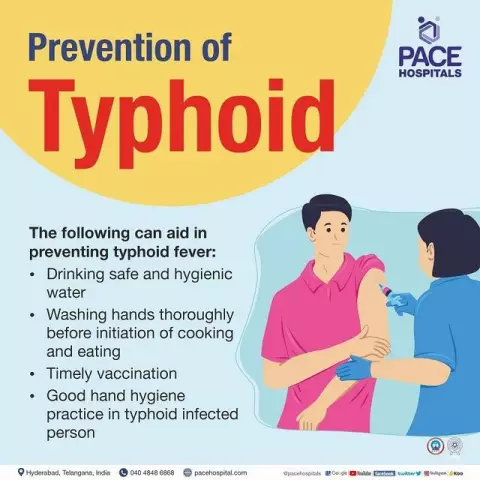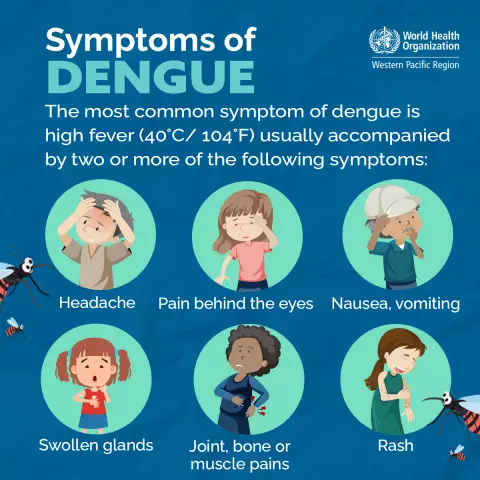- Author Rachel Wainwright [email protected].
- Public 2023-12-15 07:39.
- Last modified 2025-11-02 20:14.
Typhoid fever

An infectious disease that occurs with damage to the intestinal lymphatic system, severe intoxication and bacteremia, roseolous rash, enlarged liver, spleen and, in some cases, with enteritis is called typhoid fever.
The cause and mechanism of development of the disease
The causative agent of typhoid fever is the typhoid bacillus. It multiplies in the intestinal lumen, and then through its mucous membrane begins to penetrate into the lymphatic apparatus (Peyer's patches, solitary follicles, regional lymph nodes). Subsequently, microbes from the lymph nodes enter the circulatory system, leading to the development of bacteremia. With the death of the causative agent of typhoid fever, a toxin is released, which causes the development of severe intoxication of the patient's body.
Epidemiology of typhoid fever
The source of infection are patients and bacilli carriers, which excrete the causative agent of typhoid fever with urine and feces. A particular danger is posed by carriers of typhoid bacillus, working in child care facilities and food establishments.
The microbe enters the human body through the mouth. There are the following ways of infection with typhoid fever:
- Contact and household;
- Food grade;
- Water.
Flies play an important role in the transmission of infection.
People of any age are susceptible to typhoid fever, but most often it affects school-age children. After it, a specific and fairly stable immunity is formed, therefore, repeated cases of typhoid fever are practically not observed.
Typhoid fever: symptoms
The incubation period, i.e. the period from the moment of infection to the appearance of the first symptoms of the disease with typhoid fever is on average two weeks.
The disease begins to develop gradually with an increase in body temperature. The temperature rises in steps and reaches 40 degrees C. The patient's general malaise increases, appetite disappears, constipation occurs, sleep is disturbed.
Palpation of the abdomen reveals an enlarged liver and spleen, rumbling in the right iliac abdomen. The tongue is coated with a thick layer of plaque, swollen. Teeth prints are often visible along its edges.
A week after the onset of the first symptoms of typhoid fever, the patient begins to appear deafened, drowsy, delirious.
With typhoid fever, there is a relative bradycardia - a discrepancy between the pulse rate and the patient's temperature. This symptom of typhoid fever occurs due to severe intoxication and damage to the cardiovascular system.
On the 9-10th day from the onset of the disease, a small, pale pink roseola rash appears on the skin of the back, chest and abdomen. The elements of the rash are slightly raised above the skin and disappear with pressure on them.
After 10 to 15 days from the onset of an increase in body temperature, the symptoms of typhoid fever begin to gradually disappear. The body temperature decreases lytically (smoothly) and a period of convalescence (recovery and restoration of the body) begins.
Complications of typhoid fever
Complications of typhoid fever are usually rare and are most common in young children and the elderly. They are associated with an ulcerative process in the intestine: perforation of ulcers and / or bleeding from them.
Tests for typhoid fever
Diagnosis of typhoid fever, especially in the early stages of the disease, presents certain difficulties. Laboratory diagnostic methods are used to confirm the diagnosis. At the very beginning of the disease, blood culture (blood culture) is performed. For this analysis for typhoid fever, 10.0 ml of blood is taken from the patient's vein and, subject to aseptic measures, is transferred into a sterile glass vial containing bile broth.
Starting from the beginning of the second week of illness, the Vidal reaction is staged. This test for typhoid fever is more valuable when repeated, when an increase in antibody titer can be detected.

From the 15th day from the onset of the disease, bacteriological culture of feces and urine is performed.
In the very first days of the disease, a general blood test reveals moderate leukocytosis (an increase in the number of leukocytes), which is later replaced by leukopenia (a decrease in the number of leukocytes).
Thus, tests for typhoid fever allow doctors to timely and accurately make the correct diagnosis and prescribe the correct treatment to the patient.
Typhoid fever: treatment
With typhoid fever, it is very important for patients to adhere to strict bed rest, which should begin from the first days of the illness and continue for at least two more weeks after the body temperature has returned to normal.
Medication for typhoid fever is performed using antibiotics. The most commonly used are chloramphenicol or ampicillin. Antibiotic therapy is continued after the temperature subsides.
With severe intoxication, detoxification therapy is carried out (intravenous administration of saline solutions, glucose, vitamins).
Diet therapy plays an important role in the correct treatment of typhoid fever. The patient is allowed pureed soups, dairy products, jelly, vegetable purees, soft-boiled eggs, steam cutlets, white bread croutons. Drink plenty of fluids, which helps to reduce the severity of symptoms of intoxication.
Typhoid fever: prevention
In the fight against the spread of this disease, a well-organized sanitary service overseeing food and water plays an important role. It is necessary to conduct regular examinations for the carriage of typhoid bacillus of employees of children's institutions, water intake, catering establishments, etc., which is an important measure for the prevention of typhoid fever.
All patients should be isolated until complete recovery. Their discharge from the hospital can be made only after negative results of three-fold bacteriological studies of feces and urine.
In the focus of the disease, the current, and after the hospitalization of the patient or his recovery, the final disinfection must be carried out.
Personal prevention of typhoid fever consists in the strictest observance of usual sanitary and hygienic measures - washing hands after using the toilet and before eating, washing vegetables and fruits before eating. Do not drink raw water from unverified sources.
YouTube video related to the article:
The information is generalized and provided for informational purposes only. At the first sign of illness, see your doctor. Self-medication is hazardous to health!






